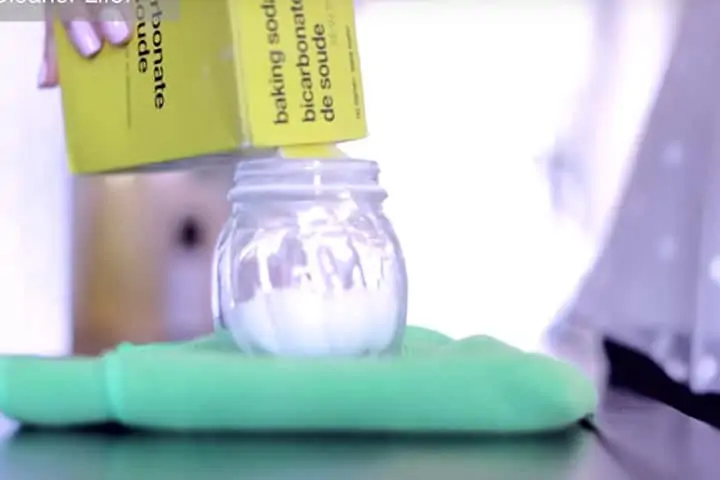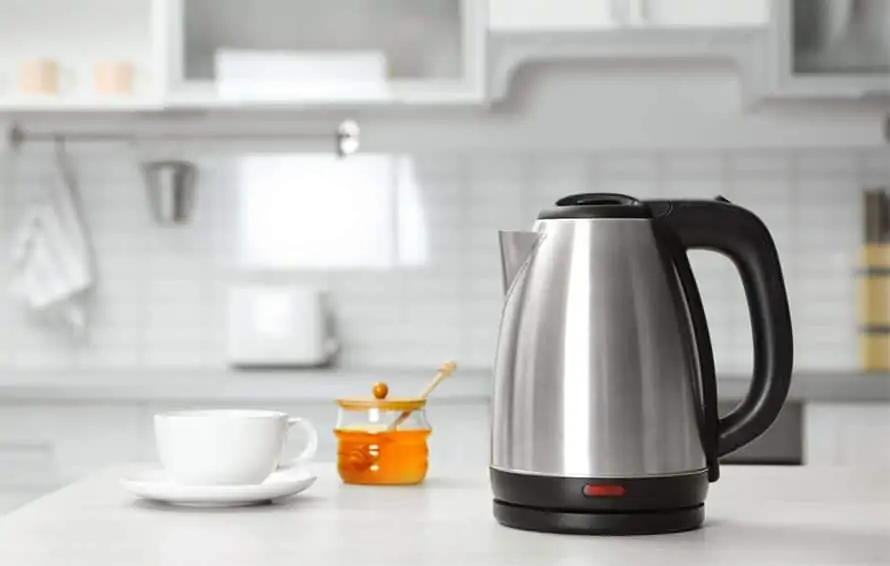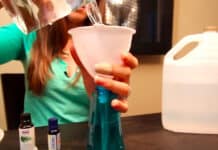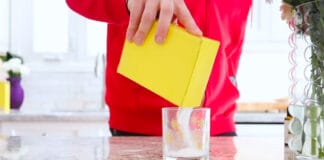Coffee and tea, most adults can’t live without them. I know I can’t. In my house, it’s tea for me and coffee for Chad first thing in the morning, or nobody gets any work done. Last week, I wrote an article on Cleaning A Keurig Coffee Maker, so if you’re a Keurig guy or gal, be sure to give that a read.
But for all of you kettle-users, today I’m going to teach you how to clean an electric kettle and stovetop kettle, and how to descale a kettle. Plus, I’ll let you in on a professional cleaning secret if you need to know how to get fingerprints off stainless steel kettles.
You don’t have to clean kettles very often, but when you see that limescale buildup on your kettle, you know it’s time to clean. Limescale buildup looks white and chalky. It won’t harm you, but it’s not very appetizing. And it doesn’t look great in your nice, clean kitchen. So make your morning caffeine ritual (or decaffeinated tea ritual, no exclusion here!) as relaxing as possible before you have to face your day.

How To Clean An Electric Kettle and Stovetop Kettle
The first step to cleaning an electric kettle is unplugging it! NEVER start cleaning your kettle while it’s plugged in. Of course, this doesn’t apply to stovetop kettles, but no matter what type of kettle you have, make sure it is cool before you begin to clean.
Once your kettle is completely cool, fill a bowl with hot water and a teaspoon of dish soap. Copper and stainless steel kettles are easily scratched, so only use a microfiber cloth or non-scratch sponge for cleaning and drying. Take your non-scratch sponge, and wipe your kettle down with the hot water and soap solution. Then, use your sponge to rinse off the soap solution, so your kettle doesn’t feel sticky. Never submerge an electric kettle in water.
For any stubborn spots, like watermarks or limescale, you’re going to make a cleaning solution of equal parts white vinegar and water. This solution should be gentle enough for your electric kettle, but be sure to check the manufacturer’s instructions. If you’re unsure, test a small spot at the bottom of your kettle before proceeding. This takes a little extra time, but it will save you from potentially ruining your kettle.
If your kettle is enamel or stainless steel, you can mix baking soda and white vinegar to make a paste. There’s no perfect recipe here; you just want a paste-like consistency.
Take your vinegar solution or your paste, and apply it to those stubborn spots on the outside of your kettle. Then scrub like your life depends on it! Or, at least scrub like your morning coffee depends on it.
Finally, if you want a little extra sparkle, take a spray bottle and fill it halfway with water and halfway with vinegar. Then, take a clean microfiber cloth and give it a spritz. Buff your kettle with your damp microfiber cloth, and voila.

How To Get Fingerprints Off Stainless Steel and Other Materials
I’m going to let you in on a professional cleaning secret. Have you ever noticed that no matter how often you wipe your kettle, it seems to get permanent fingerprint marks? I have a magic cleaning trick for you. And no, it doesn’t involve sawing someone in half.
If you want to get rid of fingerprints on your kettle, try baby oil. Apply a drop of baby oil to a clean, damp microfiber cloth. Buff the surface of your kettle with this. Then, follow with a dry paper towel to ensure your kettle doesn’t feel slippery or oily.
This trick will work on most kettles that retain fingerprints, but once again, be sure to check manufacturer instructions and do a small test patch before you go to town.

How To Descale A Kettle (Electric or Stove Top)
So, we’ve covered the outside of your kettle. But what about the inside? I can hear the gasps of dismay coming through my computer as I type. “Melissa, it’s the inside of my kettle! It’s already clean!” Well, that’s where you’re wrong.
Just like water and limescale can buildup on the outside of your kettle, it can (and does) build up on the inside. This means you have to descale your kettle– i.e. de-limescale your kettle– every few months. I like to do this when I do a full deep clean of my kitchen.
Fill your kettle with a 1:1 solution of water and vinegar. Bring this to a boil, and then turn off the heat and let your kettle sit with this solution for 20 minutes. Then, discard the solution and rinse. If you’re worried about a vinegar smell, you can fill your kettle with water and boil again. Then discard. This will remove any lingering vinegar.
Vinegar is key to getting your kettle clean, but it’s also a great cleaning staple in a lot of other areas. To learn more about how to clean with vinegar, read 5 Clever Vinegar Hacks. cleaning, check
Clean Your Electric Kettle and Stove Top Kettle
Whether you have a fancy electric kettle or a classic stovetop kettle, I’m sorry to say you will need to clean your kettle from time to time. I often clean my kettle at the same time I clean my self-cleaning oven, to make sure I don’t forget.
When you have a nice clean kettle, you’ll enjoy your morning coffee a little bit more. And that sneaky afternoon coffee too. And while you wait for your water to boil in your clean kettle, read our article 5 Minute Cleaning Jobs: Cleaning Hacks for Cleaning Fast to learn a whole bunch of little cleaning tasks you can get done in the time it takes your water to boil.
Looking for a BETTER & EASIER Way to Clean Your Home?
Cleaning Expert Melissa Maker is here to help with her game-changing 3 Wave Cleaning System that will help you clean your house faster and easier than you ever thought possible!

















Very important to boil just the amount of water you require – kettles consume a great deal of energy to boil so quickly, so 2 things – it costs a lot and above all else, it causes CO2 to be produced. A smart thing to do is measure only the amount of water you need in the kettle, then pour it into the pot.